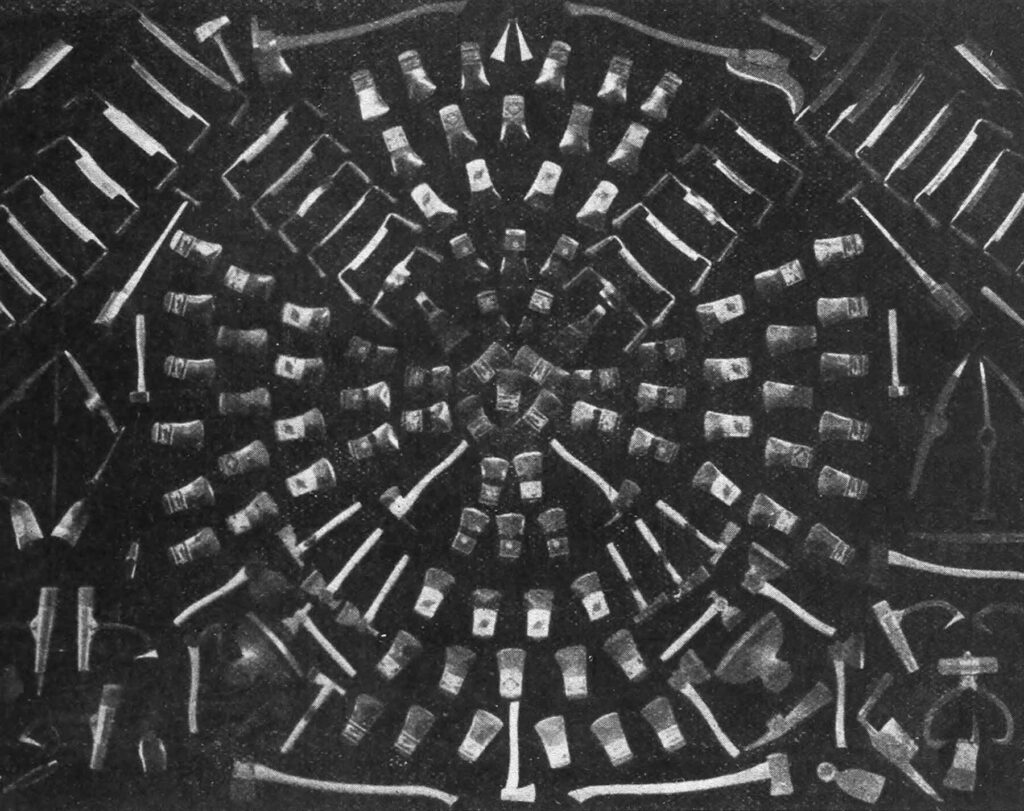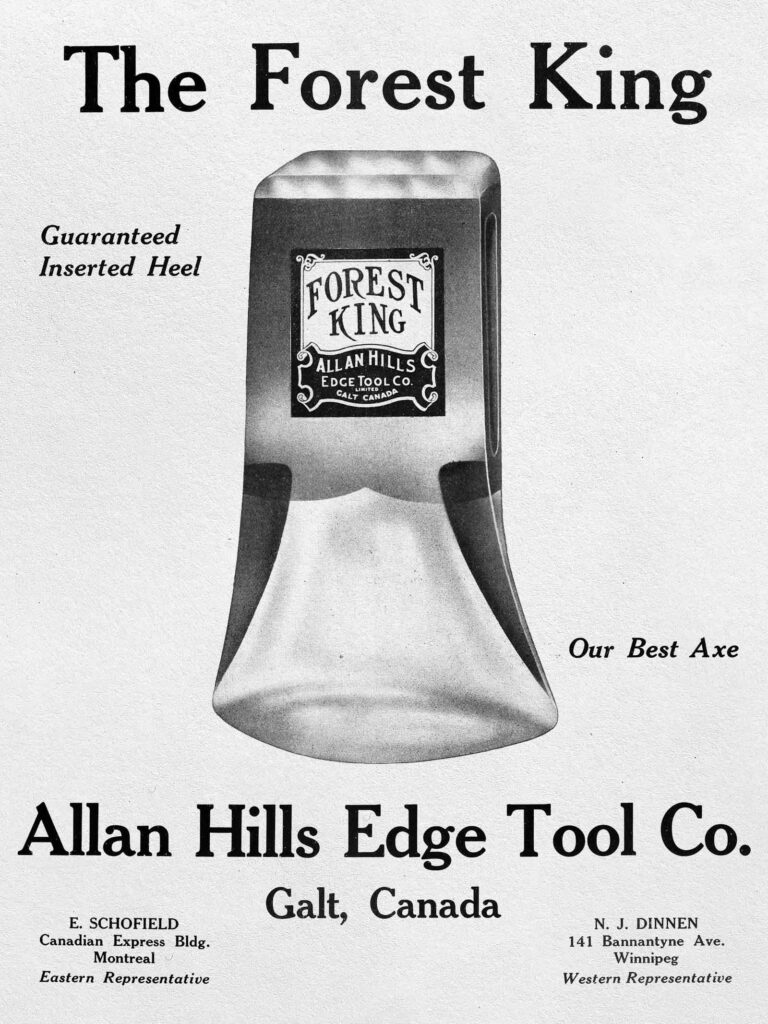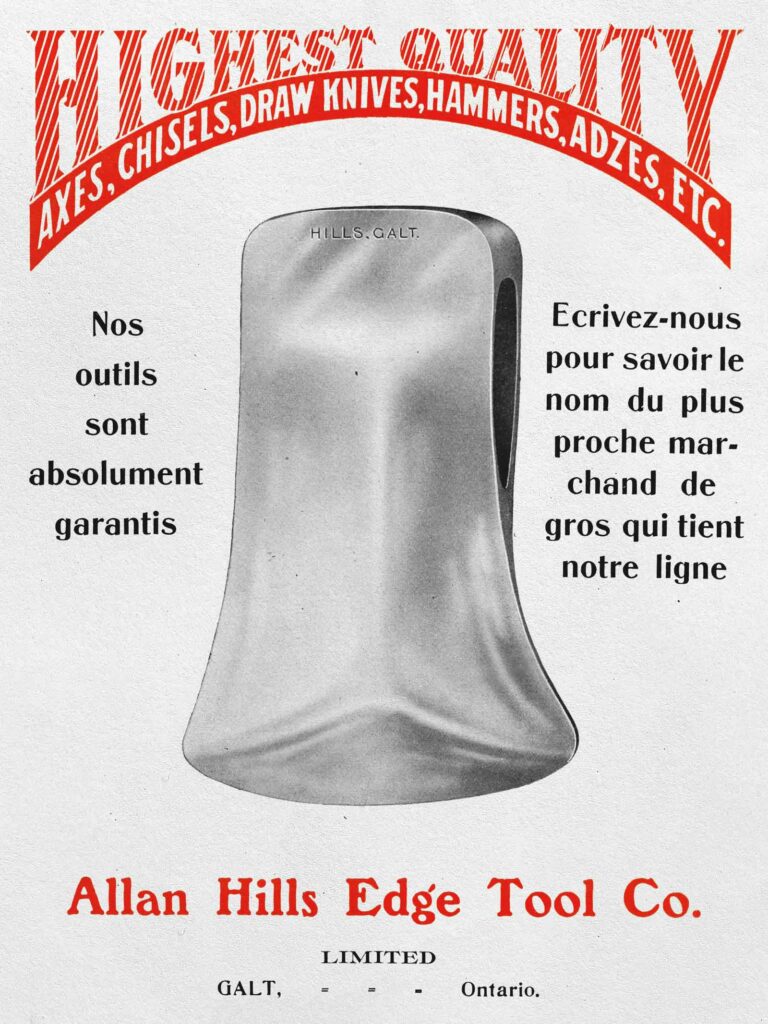Allan Hills Edge Tool Company
1909-1916
Galt (Cambridge), Ontario

Thanks to Amsterdam Iron for the picture

Allan Hills Edge Tool Co. was an ambitious but short-lived tool company that produced a wide range of axes, chisels, draw knives, pick-axes, adzes, and other lumbering tools between 1909-1916. It operated in Galt, Ontario out of a factory previously owned by James Warnock & Co.
The British businessman Allan Hills moved to Canada and purchased the defunct James Warnock & Co factory in the summer of 1909 with the support of (or possibly representing) investors from England’s steel industry. The plant was refurbished and re-opened under the name Allan Hills Edge Tool Company.
Despite quick growth in the early years, the company came to an end in 1916. This may have been a result of the poor business conditions during the First World War, or possibly the death of Mr. Hills (unconfirmed).
Allan Hills tools can still be found today, identified by the markings “HILLS – GALT”.
The Short History of Allan Hills Edge Tool Co.
James Warnock & Co. filed for insolvency and shut down in the summer of 1908. It briefly re-opened at reduced capacity to run through remaining stock for the creditors before shuttering later in the year.
In the summer of 1909, an offer to purchase the plant was approved by the liquidator, and the factory started to be refurbished.
Axe and tool production started swiftly and a full line of products was ready to be displayed at the start of 1910 – only months after the deal was approved.
Aggressive Launch
The company began aggressive advertising and marketing efforts immediately running full and half-page ads in multiple trade publications, and showcasing products in exhibits across Canada.
Allan Hills maintained the original Warnock axe brands for the first couple of years. The axes were probably stamped with the Hills name, and it’s possible the labels were modified to say Hills instead of Warnock – but the old designs were likely used for a few reasons:
- To piggyback off the reputation of the previous well-known brands.
- Artwork for the labels was already available to be used while production and orders were sorted
- Creating new etched print blocks for various publications takes time and money
Growth & Transformation
By 1912 the company was focusing on expansion and focusing the company’s image to be seen as a top-tier, Canadian brand.
They launched new axe lines with large full-page ads showing high-quality etching, expanded to new products, and released a catalog with large illustrations of their entire product line.
The Allan Hills Edge Tool Co., Gait, Ont., have issued their catalogue for 1912. The book contains illustrations of the various lines manufactured by the firm, including their bench axes and adze and chopping axes… This firm purchases only the best raw materials and have built up an enviable reputation as manufacturers of edge tools of all kinds.
CANADIAN HARDWARE, STOVE & PAINT JOURNAL, Vol 4, No.3 – March 1912
Hills reported strong sales to the logging industry in BC and growing recognition in the login industry. They mentioned in one article a single order to a company in BC filling four train cars.
The tough times (1913-1916)
Unfortunately for Allan Hills, the company was founded around the start of a tough time for Canadian tool makers.
Labor shortages were starting as workers demanded higher pay, the cost of materials was going up, and a growing number of American-made axes flooded into Canada. These American axes made at giant factories were often sold at a low price to undercut the smaller Canadian producers.
In a smart move, Allan Hills focused their advertising on being Canadian-made, and national pride. And in a trade publication from the time, they wrote about the success of the efforts allowing them to maintain sales despite the soft market.
However, the bad luck continued and the World plunged into war in 1914 – throwing the industry into further turmoil. It’s unclear exactly what happened in the end, but the company shut down for good in 1916.
Why did the factory Close?
The company likely closed due to poor market conditions, and increased cost of steel during the war. Possibly at the direction of hidden British ownership (more on that further down) that no longer thought the small Canadian company was worth the trouble during the war effort.
There is a chance Mr. Hills died in 1916, causing the plant to close – but that is unconfirmed.
Who Was Allan Hills?
Allan Hills was born in England in 1880 and established himself in the steel manufacturing industry. Before coming to Canada he was employed in an “important position” with a large high-quality steel manufacturer Wm. Jessop & Sons in Sheffield, England.(6)
Sheffield “the city of steel” was made famous for the invention of crucible steel in 1742, and by the mid-1800’s was responsible for nearly half the steel output of Europe.(5,6)

Mr. Hills immigrated to Canada with his wife Mary in 1908, settling in Galt and promptly purchasing the defunct Warnock factory in 1909 with support from (or on behalf of) investors in England. He was said to have significant personal wealth himself and also bought into partial ownership of another local company in 1912.
Tom Lamond of yesteryeartools reports Mr. Hills’ death in 1916 – however, the other info in this article suggests he may have found the right person, and lack of any evidence means this has not been confirmed (I don’t believe it to be true).(6)
Who Really Purchased the Warnock Factory?
A foreign company with large capital has made an offer for the factory of the defunct James Warnock Edge Tool Works, Galt. The offer is said to be acceptable to the liquidator.
Hardware & Metal – July 1909
Hills’ employer Wm. Jessop & Sons may have actually been the primary purchaser of the old Warnock plant. Sending Hills to operate on their behalf as a “Canadian” figurehead. This has not been proven, but there is plenty of evidence:
- Mr. Hills moved to the small town of Galt, from England the same year the Warnock plant filed for insolvency, seemingly with intent and financing already secured.(1,4)
- Early reports stated the purchase was by a “foreign company“
- The offer was backed by investors with “unlimited British capital“.(7,8)
- Within months of the purchase a full line of tools was being made with “Genuine Sheffield Steel“, so a steel supply from England must have been in place already.(7)
- Wm. Jessop & Sons always branded their steel with the exact wording used by Allan Hills.
- The head chemist from Wm. Jessop & Sons was “engaged” from the start to “devote his attention exclusively to the hardening and tempering of all steel used”.(7)

British steel was held in high regard, but toolmakers were struggling to compete in North America. So, there would have been a lot of good reasons the large English company would want to open a Canadian operation to tap into the North American Market.
Sources:
- Hardware & Metal, Vol. XX. – July 25, 1908, No. 30
- Canadian Lumberman 1901
- Yesteryeartools – Allan Hills Edge Tool Co.
- Waterloo Regions Generations – Allan Hills
- The South Yorkshire Steel Industry and the Industrial Revolution
- Wm. Jessop & Sons. Steel manufacturers, Sheffield.
- Hardware & Metal, Vol. XXII. – January 1, 1910, No. 1






